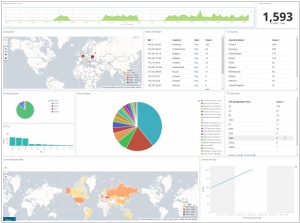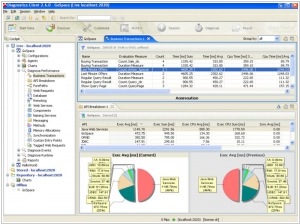ELK vs dynaTrace
Author: Michael Stromann
13

ELK is the acronym for three open source projects: Elasticsearch, Logstash, and Kibana. Elasticsearch is a search and analytics engine. Logstash is a server‑side data processing pipeline that ingests data from multiple sources simultaneously, transforms it, and then sends it to a "stash" like Elasticsearch. Kibana lets users visualize data with charts and graphs in Elasticsearch.
ELK and Dynatrace are both popular tools used in the field of IT monitoring and observability, but they have some key differences:
Functionality: ELK (Elasticsearch, Logstash, and Kibana) is an open-source software stack that provides a powerful and flexible platform for collecting, processing, storing, and visualizing log data and other types of data for analysis and monitoring. It is commonly used for log management, security monitoring, and application performance monitoring (APM), among other use cases. Dynatrace, on the other hand, is a commercial, all-in-one observability platform that provides end-to-end monitoring and observability capabilities, including APM, infrastructure monitoring, digital experience monitoring, cloud monitoring, and more. Dynatrace provides a comprehensive set of features designed for enterprise-level monitoring and observability, with advanced AI-driven analytics, automatic root cause analysis, and intelligent alerting capabilities.
Ease of Use: ELK is known for its flexibility and extensibility, but it requires more configuration and setup compared to Dynatrace, which is designed to be easy to set up and use out of the box. Dynatrace provides automatic discovery and monitoring of applications, services, and infrastructure components, with pre-built dashboards and alerts for quick insights into the health and performance of monitored systems. ELK, on the other hand, requires more manual configuration and customization to set up dashboards, alerts, and monitoring rules according to specific requirements.
Scalability: ELK is a horizontally scalable solution that can handle large volumes of data and support distributed deployments across multiple nodes. It provides flexibility in terms of data ingestion, processing, and storage options, allowing users to scale their ELK stack based on their needs. Dynatrace is also scalable, with a cloud-native architecture that can automatically scale up or down based on the monitoring needs of the environment. Dynatrace also provides a SaaS (Software as a Service) offering, which offloads the infrastructure and scalability concerns to the provider.
Pricing Model: ELK is an open-source software stack, which means that it is free to use, but users are responsible for setting up and managing their own infrastructure, as well as handling upgrades and maintenance. Dynatrace, on the other hand, is a commercial product with a subscription-based pricing model. It offers different pricing tiers based on the features and capabilities needed, with options for cloud-based or on-premises deployments. The pricing of Dynatrace may be a consideration for organizations with budget constraints, while ELK may be more appealing for organizations looking for a cost-effective solution with more control over their infrastructure.
Integration: ELK is known for its open architecture and wide range of integrations, allowing users to easily integrate it with other tools and systems in their monitoring and observability stack. ELK provides integration options with various data sources, including logs, metrics, events, and more, making it highly customizable and extensible. Dynatrace also provides integrations with other tools and systems, but it may have a more focused set of integrations compared to ELK, with a focus on its all-in-one observability platform.
In summary, the main differences between ELK and Dynatrace lie in their functionality, ease of use, scalability, pricing model, and integration options. ELK is an open-source software stack that provides flexibility and extensibility, while Dynatrace is a commercial, all-in-one observability platform with a focus on ease of use, scalability, and out-of-the-box features.
See also: Top 10 IT Monitoring software
Functionality: ELK (Elasticsearch, Logstash, and Kibana) is an open-source software stack that provides a powerful and flexible platform for collecting, processing, storing, and visualizing log data and other types of data for analysis and monitoring. It is commonly used for log management, security monitoring, and application performance monitoring (APM), among other use cases. Dynatrace, on the other hand, is a commercial, all-in-one observability platform that provides end-to-end monitoring and observability capabilities, including APM, infrastructure monitoring, digital experience monitoring, cloud monitoring, and more. Dynatrace provides a comprehensive set of features designed for enterprise-level monitoring and observability, with advanced AI-driven analytics, automatic root cause analysis, and intelligent alerting capabilities.
Ease of Use: ELK is known for its flexibility and extensibility, but it requires more configuration and setup compared to Dynatrace, which is designed to be easy to set up and use out of the box. Dynatrace provides automatic discovery and monitoring of applications, services, and infrastructure components, with pre-built dashboards and alerts for quick insights into the health and performance of monitored systems. ELK, on the other hand, requires more manual configuration and customization to set up dashboards, alerts, and monitoring rules according to specific requirements.
Scalability: ELK is a horizontally scalable solution that can handle large volumes of data and support distributed deployments across multiple nodes. It provides flexibility in terms of data ingestion, processing, and storage options, allowing users to scale their ELK stack based on their needs. Dynatrace is also scalable, with a cloud-native architecture that can automatically scale up or down based on the monitoring needs of the environment. Dynatrace also provides a SaaS (Software as a Service) offering, which offloads the infrastructure and scalability concerns to the provider.
Pricing Model: ELK is an open-source software stack, which means that it is free to use, but users are responsible for setting up and managing their own infrastructure, as well as handling upgrades and maintenance. Dynatrace, on the other hand, is a commercial product with a subscription-based pricing model. It offers different pricing tiers based on the features and capabilities needed, with options for cloud-based or on-premises deployments. The pricing of Dynatrace may be a consideration for organizations with budget constraints, while ELK may be more appealing for organizations looking for a cost-effective solution with more control over their infrastructure.
Integration: ELK is known for its open architecture and wide range of integrations, allowing users to easily integrate it with other tools and systems in their monitoring and observability stack. ELK provides integration options with various data sources, including logs, metrics, events, and more, making it highly customizable and extensible. Dynatrace also provides integrations with other tools and systems, but it may have a more focused set of integrations compared to ELK, with a focus on its all-in-one observability platform.
In summary, the main differences between ELK and Dynatrace lie in their functionality, ease of use, scalability, pricing model, and integration options. ELK is an open-source software stack that provides flexibility and extensibility, while Dynatrace is a commercial, all-in-one observability platform with a focus on ease of use, scalability, and out-of-the-box features.
See also: Top 10 IT Monitoring software



